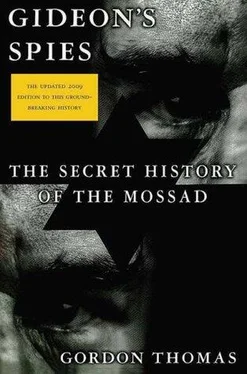Gordon Thomas - Gideon's Spies
Здесь есть возможность читать онлайн «Gordon Thomas - Gideon's Spies» весь текст электронной книги совершенно бесплатно (целиком полную версию без сокращений). В некоторых случаях можно слушать аудио, скачать через торрент в формате fb2 и присутствует краткое содержание. Город: New York, Год выпуска: 2009, ISBN: 2009, Издательство: Thomas Dunne Books, Жанр: История, на английском языке. Описание произведения, (предисловие) а так же отзывы посетителей доступны на портале библиотеки ЛибКат.
- Название:Gideon's Spies
- Автор:
- Издательство:Thomas Dunne Books
- Жанр:
- Год:2009
- Город:New York
- ISBN:978-0-312-53901-6
- Рейтинг книги:4 / 5. Голосов: 1
-
Избранное:Добавить в избранное
- Отзывы:
-
Ваша оценка:
- 80
- 1
- 2
- 3
- 4
- 5
Gideon's Spies: краткое содержание, описание и аннотация
Предлагаем к чтению аннотацию, описание, краткое содержание или предисловие (зависит от того, что написал сам автор книги «Gideon's Spies»). Если вы не нашли необходимую информацию о книге — напишите в комментариях, мы постараемся отыскать её.
Gideon’s Spies
Gideon's Spies — читать онлайн бесплатно полную книгу (весь текст) целиком
Ниже представлен текст книги, разбитый по страницам. Система сохранения места последней прочитанной страницы, позволяет с удобством читать онлайн бесплатно книгу «Gideon's Spies», без необходимости каждый раз заново искать на чём Вы остановились. Поставьте закладку, и сможете в любой момент перейти на страницу, на которой закончили чтение.
Интервал:
Закладка:
Then, in April 1997, Rafi Eitan’s name began to surface in connection with a Mossad spy in Washington whom the FBI identified and code-named “Mega.”
His own well-placed source within Mossad had told Rafi Eitan that the FBI had begun to explore the role Mega could have had in the way Jonathan Pollard had been run. Had Mega been the source for some of the ultrasecret material Pollard had passed on? The FBI had recently reinterviewed Pollard in prison and he had admitted that even his high security clearance had not been enough to obtain some of the documents his handler, the funereal Yagur, had requested. The FBI knew such documents had a special code word through which they had to be accessed, which changed frequently, sometimes even on a daily basis. Yet Yagur had seemed to know the code within a matter of hours to give to Pollard. Had Mega provided it? Was Mega the second Israeli spy in Washington the FBI had long suspected? How close had he been to Rafi Eitan?
These were the dangerous questions now being asked in Washington that could shatter the relationship between Washington and Tel Aviv.
After the FBI had identified him as the puppet master behind Pollard, Rafi Eitan had accepted that his time in Israeli intelligence was finally over. He had looked forward to ending his days facing no greater risk than being scorched from the blowtorch he wielded when forming his sculptures.
Instinctively he knew that events in Washington posed a threat not only to him—a CIA snatch squad could try to grab him as he came and went from Cuba and bring him to Washington for questioning, and there was no way of telling what would happen then; but the discovery of Mega’s existence would also be exercising minds in the upper echelons of the Israeli intelligence community’s Va’adat Rashei Hasherutim—the Committee of the Heads of Service whose primary function is to coordinate all intelligence and security activities at home and abroad.
But even they knew nothing about who Mega was. All they had been told was that he was highly placed in the Clinton administration. Whether the president had inherited him from the Bush government was another carefully guarded secret. Only the incumbent Mossad memune knew how long Mega had been in place.
The committee members did, however, know that the FBI’s counterintelligence division finally believed that the lack of action against Mossad was due to the power of the Jewish lobby in Washington, and the reluctance of successive administrations to confront it. Once more that lobby could be called upon to dampen the firestorm building since Mega had first been discovered by the FBI. On February 16, 1997, the National Security Agency (NSA) had provided the FBI with an intercept of a late-night telephone conversation from the Israeli embassy between a Mossad intelligence officer identified only as Dov, and his superior in Tel Aviv, whose name had not been revealed during the short conversation.
Dov had asked “for guidance” as to whether he “should go to Mega” for a copy of a letter written by Warren Christopher, then secretary of state, to PLO chairman Yasser Arafat. The letter contained a set of assurances given to Arafat by Christopher on January 16 about the withdrawal of Israeli troops from the West Bank city of Hebron. Dov was instructed by the voice in Tel Aviv “to forget the letter. This is not something we use Mega for.”
The brief conversation had been the first clue the FBI had of the importance of Mega. The code name had not been heard before in its around-the-clock surveillance of the Israeli embassy and its diplomats. Using state-of-the-art computers, the FBI narrowed the urgent search for the identity of Mega to someone who either worked there or had access to a senior official employed by the National Security Council, the body that advises the president on intelligence and defense-related matters. Its office is in the White House, and its members include the vice president and the secretaries of state and defense. The director of Central Intelligence and the chairman of the Joint Chiefs of Staff serve in an advisory role. The permanent staff is headed by the president’s national security adviser.
How the Israeli embassy had learned its secure communications channel with Tel Aviv had been breached still remained as closely guarded as the identity of Mega. Like all Israeli missions, the Washington embassy was constantly updated with more sophisticated systems for encryption and burst transmissions: a significant portion of this equipment has been adapted from stolen U.S. blueprints.
On February 27, 1997, a pleasant spring morning in Tel Aviv, the members of the Committee of the Heads of Services drove from their various offices around the city along the broad road called Rehov Shaul Hamaleku to a guarded gate in a high blank wall tipped with barbed wire. All that could be seen of what lay behind the wall were the roofs of buildings. Rising above them was a massive concrete tower visible all over Tel Aviv. At various heights were unsightly clusters of electronic antennae. The tower was the centerpiece of the headquarters of the Israel Defense Forces. The complex is known as the Kirya, which simply means “place.”
At a little before 11:00 A.M., the intelligence chiefs used their swipe cards to access a building near the tower. Like most Israeli government offices, the conference room they entered was shabby.
The meeting was chaired by Danny Yatom, who had recently been appointed as Mossad’s latest chief by Prime Minister Benyamin Netanyahu. Yatom had a reputation as a hard-liner, very much in keeping with Netanyahu. The Tel Aviv rumor mills had it that the new Mossad chief had “baby-sat” the embattled prime minister when Netanyahu’s colorful private life threatened his career. The men around the cedarwood conference table listened attentively as Yatom outlined the strategy to be adopted should the “situation” with Mega become a full-blown crisis.
Israel would deliver a strongly worded protest that its Washington embassy’s diplomatic status had been violated by the bugging—a move that would undoubtedly cause embarrassment to the Clinton administration. Next, sayanim connected to the U.S. media should be instructed to plant stories that Mega was an incorrect decoding of the Hebrew slang Elga, which had long been Mossad-speak for the CIA. Further, the word Mega was part of one well-known to U.S. intelligence. Megawatt was a code name it had until recently used jointly with Mossad to describe shared intelligence. For good measure sayanim should add that another word, Kilowatt, was used for commonly shared terrorist data.
But, for the moment, nothing would be done, Yatom concluded.
In March 1997, on receipt of information from Mossad’s katsa in Washington, Yatom took action. He sent a yahalomin team to Washington to follow-up on the katsa ’s report that President Clinton was repeatedly indulging in phone-sex calls with a a former White House aide, Monica Lewinsky. He was making the calls from the Oval Office to her apartment in the Watergate complex. Knowing that the White House was totally protected by electronic counter-measures, the yahalomin team focused on Lewinsky’s apartment. They began to intercept explicit phone calls from the president to Lewinsky. The recordings were couriered by diplomatic bag to Tel Aviv.
On March 27, Clinton once more invited Lewinsky to the Oval Office and revealed he believed a foreign embassy was taping their conversations. He did not give her any more details, but shortly afterwards the affair ended.
In Tel Aviv, Mossad’s strategies pondered how to use the highly embarrassing taped conversations; they were the stuff of blackmail—though no one suggested any attempt should be made to blackmail the president of the United States. Some, however, saw the recordings as a potent weapon to be used if Israel found itself with its back to the wall in the Middle East and unable to count on Clinton’s support.
Читать дальшеИнтервал:
Закладка:
Похожие книги на «Gideon's Spies»
Представляем Вашему вниманию похожие книги на «Gideon's Spies» списком для выбора. Мы отобрали схожую по названию и смыслу литературу в надежде предоставить читателям больше вариантов отыскать новые, интересные, ещё непрочитанные произведения.
Обсуждение, отзывы о книге «Gideon's Spies» и просто собственные мнения читателей. Оставьте ваши комментарии, напишите, что Вы думаете о произведении, его смысле или главных героях. Укажите что конкретно понравилось, а что нет, и почему Вы так считаете.












